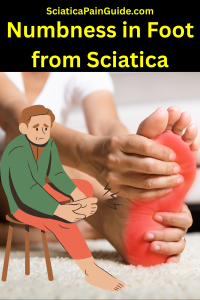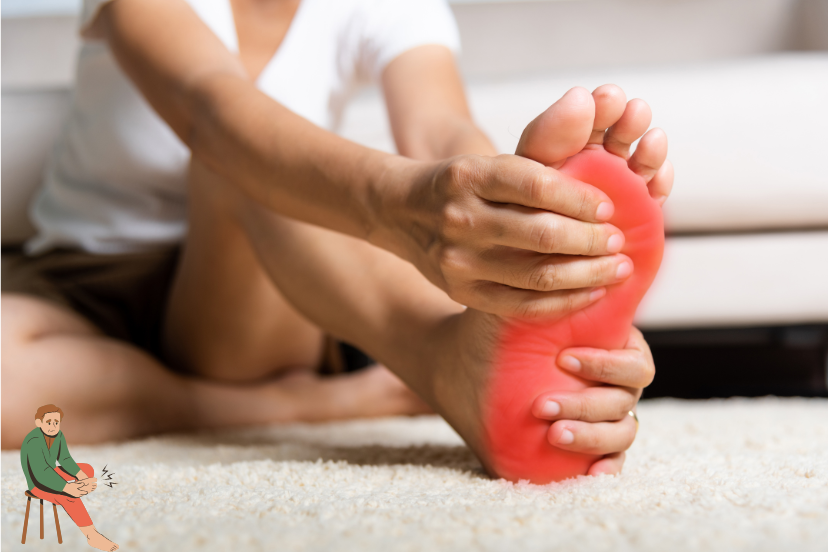Numbness in Foot from Sciatica: Causes, Treatments, and Relief Strategies
Understanding Numbness in Foot from Sciatica
If you’ve ever felt your foot go numb after sitting too long, you know how frustrating it can be. But when numbness lingers — especially alongside lower back pain, leg weakness, or burning sensations — it could be a sign of sciatica. Many people in the U.S. experience numbness in foot from sciatica, often caused by pressure on the sciatic nerve. This condition can make everyday activities like walking, driving, or even getting comfortable in bed a constant struggle.
The good news? There are ways to manage and even reduce these symptoms with the right treatment plan. This guide will walk you through causes, treatments, prevention tips, and practical strategies to find lasting relief.
What Causes Numbness in Foot from Sciatica?
The sciatic nerve is the longest nerve in the body, running from the lower back down through the buttocks and legs. When this nerve gets compressed or irritated, it can trigger a range of symptoms — including numbness in the foot.
Common Causes of Sciatic Nerve Compression
-
Herniated Disc: One of the leading causes of sciatica is when a spinal disc bulges and presses on the nerve roots.
-
Spinal Stenosis: Narrowing of the spinal canal that squeezes the sciatic nerve.
-
Piriformis Syndrome: Tightness or spasms in the piriformis muscle can pinch the sciatic nerve.
-
Degenerative Disc Disease: Age-related changes that weaken discs and irritate the nerves.
-
Bone Spurs: Extra bone growth pressing on the sciatic nerve roots.
When compression occurs, signals from the nerve don’t travel properly, leading to numbness, tingling, or weakness in the foot and leg.
Recognizing Symptoms Beyond Foot Numbness
Numbness is only one part of the picture. Many people experience a combination of symptoms:
-
Sharp or burning pain running down the leg (sciatica pain running down leg)
-
Tingling or “pins and needles” in the toes or foot
-
Weakness in the ankle or difficulty lifting the foot (foot drop)
-
Pain that worsens when sitting with sciatica for long periods
-
Relief when lying down or changing positions
Quick Answer: Numbness in foot from sciatica happens when pressure on the sciatic nerve interrupts normal signals to the foot.
When to See a Doctor for Foot Numbness
While occasional tingling may go away with rest, persistent numbness in foot from sciatica should never be ignored. Seek medical attention if you experience:
-
Sudden severe weakness in the leg or foot
-
Loss of bladder or bowel control
-
Numbness spreading to the groin or inner thighs
-
Symptoms lasting longer than a few weeks despite home care
These may indicate a more serious condition requiring urgent treatment.
Effective Treatments for Numbness in Foot from Sciatica
1. Home Remedies and Self-Care
Many people find relief with at-home strategies, especially in mild to moderate cases:
-
Heat or Ice for Sciatica: Ice reduces inflammation during flare-ups, while heat relaxes tight muscles. Alternate between the two.
-
Gentle Sciatica Stretches at Home: Moves like the knee-to-chest stretch or seated piriformis stretch can ease pressure on the nerve.
-
Best Sleeping Position for Sciatica: Sleeping on your side with a pillow between the knees can reduce nerve irritation.
-
Walking with Sciatica Pain: Short, frequent walks can improve circulation and reduce stiffness.
2. Over-the-Counter and Prescription Medications
-
NSAIDs (ibuprofen, naproxen): Reduce inflammation and pain.
-
Muscle relaxants: Helpful if muscle spasms contribute to nerve compression.
-
Prescription nerve pain medications: Such as gabapentin or pregabalin, sometimes prescribed for chronic sciatica.
3. Physical Therapy
Sciatica physical therapy programs focus on strengthening the core, improving flexibility, and correcting posture to relieve nerve pressure. Exercises for sciatica pain relief often include:
-
Hamstring stretches
-
Pelvic tilts
-
Core stabilization exercises
-
Low-impact aerobic activity (swimming, stationary biking)
4. Advanced Medical Treatments
If conservative methods fail, doctors may recommend:
-
Epidural steroid injections: Targeted relief by reducing inflammation around the nerve.
-
Minimally invasive surgery: Procedures like microdiscectomy to remove pressure from a herniated disc.
-
Spinal decompression surgery: For severe spinal stenosis cases.
Lifestyle Changes to Prevent Sciatica Flare-Ups
Preventing numbness in foot from sciatica often comes down to daily habits:
-
Ergonomic sitting: Use a chair with lumbar support, and keep your feet flat on the floor.
-
Regular exercise: Core strengthening and low-impact cardio protect the spine.
-
Weight management: Extra weight increases stress on the lower back.
-
Avoid prolonged sitting or standing: Take breaks every 30–60 minutes.
-
Proper lifting techniques: Bend at the knees, not the waist.
Stretches and Exercises for Foot Numbness Relief
Here are three simple stretches that can help reduce foot numbness from sciatic nerve irritation:
-
Seated Piriformis Stretch
-
Sit on a chair, cross one ankle over the opposite knee.
-
Gently lean forward until you feel a stretch in the buttock.
-
Hold for 20–30 seconds per side.
-
-
Knee-to-Chest Stretch
-
Lie on your back, pull one knee gently toward your chest.
-
Keep the other leg extended.
-
Hold for 20–30 seconds per leg.
-
-
Cat-Cow Stretch
-
Start on all fours, arch your back upward (cat), then drop your belly down while lifting your head (cow).
-
Repeat 10 times slowly.
-
Always consult a healthcare provider before starting new exercises, especially if you have chronic sciatica.
Real-Life Coping Strategies for Living with Sciatica
Managing chronic sciatica often requires combining treatments with lifestyle adjustments. Patients in the U.S. commonly report success with:
-
Adjustable standing desks: Reducing long hours of sitting with sciatica.
-
Supportive footwear: Cushioned shoes help when walking with sciatica pain.
-
Massage therapy and chiropractic care: Natural remedies for sciatica that complement medical treatment.
-
Mind-body approaches: Yoga, meditation, and breathing exercises help lower stress that can worsen pain.
FAQs About Numbness in Foot from Sciatica
1. Can numbness in the foot from sciatica go away on its own?
Yes, mild cases often improve within a few weeks with rest, stretching, and self-care. Persistent or worsening numbness needs medical attention.
2. Is numbness in the foot a sign of permanent nerve damage?
Not always. Temporary numbness is common, but untreated chronic compression may lead to long-term damage. Early treatment reduces this risk.
3. What’s the fastest way to relieve foot numbness from sciatica?
Applying ice or heat, gentle stretching, and short walks can provide quick relief. For severe pain, medications or injections may be necessary.
4. Does walking make sciatica numbness worse?
Short walks usually help improve circulation and reduce symptoms. However, overexertion can worsen pain — listen to your body.
5. Which exercises should I avoid if I have sciatica?
High-impact activities like running, heavy lifting, or deep forward bends can aggravate symptoms. Stick to low-impact, controlled movements.
6. Can sleeping wrong cause foot numbness from sciatica?
Yes. Poor sleeping positions, like lying flat on your back without support, may increase nerve pressure. Side sleeping with a pillow often helps.
7. When should I consider surgery for sciatica-related foot numbness?
If conservative treatments fail after 6–12 weeks, or if you develop severe weakness, surgery may be considered.
Final Thoughts: Finding Relief from Sciatica-Related Foot Numbness
Living with numbness in foot from sciatica can be frustrating, but it doesn’t have to control your life. From home remedies and lifestyle adjustments to medical treatments and physical therapy, many options exist to relieve pressure on the sciatic nerve and restore mobility.
The key is early action — don’t ignore persistent numbness. Talk to a healthcare professional, stay consistent with stretches, and make small daily changes to protect your spine. With the right plan, you can reduce pain, restore function, and get back to enjoying your life.
Disclaimer
This article is for informational purposes only and is not a substitute for professional medical advice, diagnosis, or treatment. Always consult with your healthcare provider before starting a new exercise or stretching routine, especially if you have existing back or nerve conditions.
👉 Explore more:
- Why Does Sciatica Hurt More in the Morning?
- Best Mattress for Sciatica and Back Pain
- Sciatica Relief Stretches for Beginners





